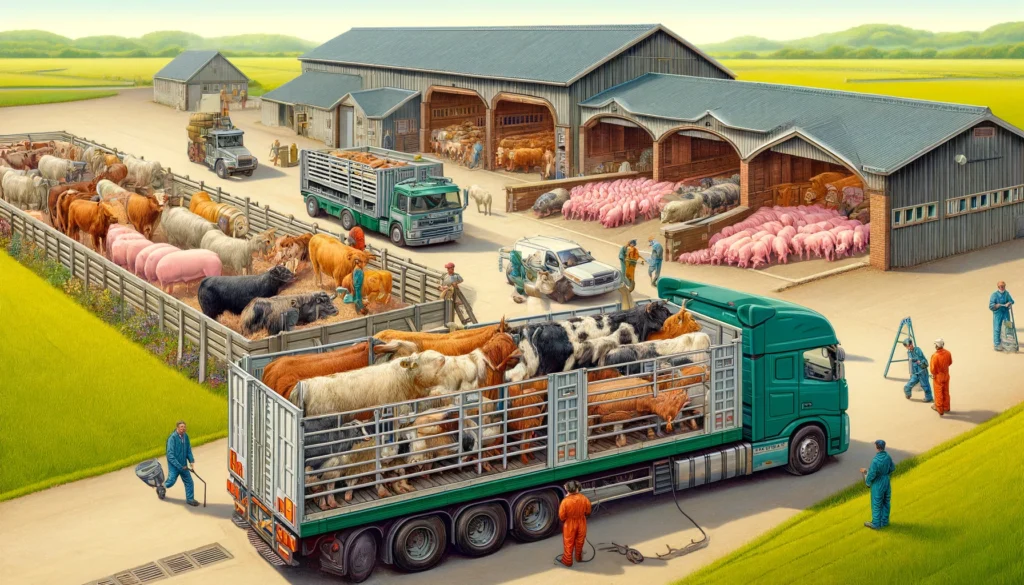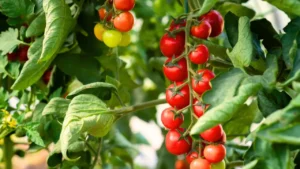
Livestock Transportation A detailed and informative illustration depicting livestock transportation on a farm. The scene shows farmers loading various animals such as cows pi 1.webp.webp
Definition: Livestock Transportation
Overview
Livestock transportation refers to the process of moving animals from one location to another, whether it be within a farm, between farms, to markets, or to slaughterhouses. This process must be conducted in a way that ensures the welfare of the animals, minimizes stress and injury, and complies with legal and regulatory standards. Proper livestock transportation is crucial for maintaining animal health, ensuring product quality, and promoting ethical farming practices.
Benefits of Proper Livestock Transportation
Improved Animal Welfare
Ensuring proper transportation practices significantly improves the welfare of livestock. Minimizing stress and preventing injuries during transport help maintain the health and well-being of animals, leading to better overall productivity and reduced mortality rates.
Fall off the barn roof and busted your keister? Life on the farm or ranch can be tough on the bum. Need a break? Laugh it off at FarmerCowboy.com, the #1 farm humor site. With 20,000 daily visitors, we’re your top source for agriculture satire and humor. Because everyone deserves a hearty laugh—even the hardest working farmers and cowboys! Join us and turn those long days into fun tales at FarmerCowboy.com.
Enhanced Product Quality
Stress and injuries during transportation can negatively impact the quality of animal products such as meat, milk, and wool. Proper transportation practices help ensure that animals arrive at their destination in good condition, maintaining the quality of the products they provide.
Compliance with Regulations
Adhering to legal and regulatory standards for livestock transportation is essential for avoiding fines and legal issues. Compliance ensures that animals are transported humanely and safely, aligning with industry best practices and societal expectations.
Components of Livestock Transportation
Transportation Vehicles
The choice of transportation vehicles is critical for the safe and humane transport of livestock. Vehicles should be designed specifically for animal transport, with features such as non-slip flooring, adequate ventilation, and appropriate space for the animals to stand or lie down comfortably.
Loading and Unloading Facilities
Proper loading and unloading facilities help minimize stress and injury during transport. Ramps, chutes, and holding pens should be designed to facilitate smooth and efficient movement of animals, reducing the risk of accidents and injuries.
Handling Practices
Humane handling practices during loading, transport, and unloading are essential for animal welfare. Handlers should be trained in low-stress techniques, using calm and gentle methods to guide animals. Avoiding the use of electric prods and other aggressive tools is important for maintaining a stress-free environment.
Techniques for Humane Livestock Transportation
Planning and Preparation
Thorough planning and preparation are key to successful livestock transportation. This includes scheduling transport during cooler parts of the day, planning the route to minimize travel time, and ensuring that vehicles and equipment are clean and in good condition.
Monitoring Animal Health
Monitoring the health and condition of animals before, during, and after transport is crucial for preventing and addressing issues. This includes checking for signs of stress, dehydration, or injury and taking appropriate action if problems are detected.
Providing Adequate Rest and Hydration
During long-distance transport, providing adequate rest and hydration is essential for animal welfare. Scheduled breaks for feeding, watering, and resting help maintain the health and well-being of livestock during transit.
Economic Considerations
Cost of Transportation
The cost of livestock transportation includes fuel, vehicle maintenance, labor, and compliance with regulatory standards. While these costs can be significant, investing in proper transportation practices can lead to long-term benefits such as improved animal health, reduced mortality rates, and higher product quality.
Return on Investment
Conducting a cost-benefit analysis helps farmers assess the return on investment for proper transportation practices. This analysis should consider factors such as reduced stress and injury, improved product quality, and compliance with legal requirements.
Environmental Impact
Fuel Efficiency and Emissions
Choosing fuel-efficient vehicles and planning efficient routes can help reduce the environmental impact of livestock transportation. Reducing fuel consumption and emissions contributes to more sustainable farming practices and minimizes the carbon footprint of agricultural operations.
Waste Management
Proper waste management during transport is important for environmental protection. Vehicles should be equipped with systems for containing and disposing of animal waste, preventing contamination and pollution during transit.
Case Studies
Case Study 1: Improved Cattle Transportation Practices
A beef cattle operation in Texas implemented humane transportation practices, including using specialized vehicles and training handlers in low-stress techniques. The farm reported a significant reduction in injury rates and improved meat quality, leading to higher market prices and customer satisfaction.
Case Study 2: Poultry Transport Efficiency
A poultry farm in Arkansas optimized their transportation practices by investing in modern vehicles with better ventilation and scheduling transport during cooler hours. These changes resulted in lower mortality rates and higher quality poultry products, enhancing the farm’s profitability and reputation.
Conclusion
Livestock transportation is a critical aspect of animal husbandry that directly impacts animal welfare, product quality, and compliance with regulatory standards. By implementing humane transportation practices, using appropriate vehicles and facilities, and ensuring proper planning and monitoring, farmers and ranchers can improve the welfare of their animals and achieve greater efficiency and profitability. Understanding the components and benefits of effective livestock transportation allows for informed decisions that contribute to the success and sustainability of agricultural enterprises.

Originally posted 2024-06-16 07:49:48.
Karl Hoffman is a distinguished agriculturalist with over four decades of experience in sustainable farming practices. He holds a Ph.D. in Agronomy from Cornell University and has made significant contributions as a professor at Iowa State University. Hoffman’s groundbreaking research on integrated pest management and soil health has revolutionized modern agriculture. As a respected farm journalist, his column “Field Notes with Karl Hoffman” and his blog “The Modern Farmer” provide insightful, practical advice to a global audience. Hoffman’s work with the USDA and the United Nations FAO has enhanced food security worldwide. His awards include the USDA’s Distinguished Service Award and the World Food Prize, reflecting his profound impact on agriculture and sustainability.






